“I call it the SEAL Team Six targeted shopping strike. It used to be for grumpy old men, but now we’re all doing it. Consumers are stressed and they are filtering out as many random signals as possible,” Dr James Richardson, founder of Premium Growth Solutions told emerging brands on a webinar Friday.
And while hoards of people stuck at home glued to phones and laptops present opportunities for creative digital marketers looking to reach us via direct-to-consumer brands (and 'stress baking' is now a thing), consumers are in a very different mindset when they go shopping in bricks & mortar stores, he observed.
“Whole Foods saw elevated foot traffic as fear ratcheted up, but now their traffic has completely collapsed as the middle class is not doing half-basket trips on Saturdays, even with Prime Now. And specialty food retail traffic [where shoppers are particularly open to discovering new brands] is truly horrendous.
“Do you want to fight for growth in a channel that’s lost half its foot traffic? I’d focus on Kroger.”
‘Those of you with DTC (direct-to-consumer) operations right now have a massive advantage’
As for which CPG brands are going to win in these circumstances, he said, “It’s established CPG brands because they have high awareness; however, there’s a subset of early stage eight-figure ($10m+) brands that could catch the surge if they are not very premium priced. Prior habituated healthy choices are also not going to collapse if they have become part of a long-term solution for chronic health issues.”
Similarly, while third, fourth, and fifth tier brands may struggle as more shoppers switch to private label and familiar brands, there is a subset of affluent shoppers that used to spend a significant sum on eating at restaurants and will still have the money – at least in the short term – to switch that spend towards premium packaged foods and beverages, if you can find the right way to reach them, he added.
He added: “Use census data to locate the zip codes where these people live and target them. Those of you with DTC (direct-to-consumer) operations right now have a massive advantage… and [if you haven’t] I’d seriously consider setting up DTC operations right now… if your category is amenable…”
For startup brands with revenues of less than $1m, this is essential, he said, “because brick & mortar channels are not very effective right now.”
For $10m+ early stage brands, he said, the immediate focus should be on inventory management, and then encouraging consumers to buy more of your product with relevant offers and short, empathetic messages and loyalty marketing.
‘Would you go up to this woman right now and talk to her about her weight management plan?’
Meanwhile, brands that try to tap into consumer desire for self-improvement will need to reframe their messaging, if they can, he added, noting that much of the premium food and beverage sector “derives its fuel from America’s cult of self-improvement.”
“Would you go up to this woman [pictured on one of his slides holding a pencil] right now and talk to her about her weight management plan?” he asked.
“I don’t think so. I wouldn’t dare because I’d probably get that pencil right in my eye. She’s got other things she’s dealing with, and this is not the time to talk about products that ask more of the individual.”
‘Emotional eating is through the roof right now’
It may, however, be the right time to talk about indulgence, stress relief, and sleep quality, he said. “Emotional eating is through the roof right now.”
And with that in mind, there is also a subset of products for which demand is very elastic, he added, citing salty snacks, chocolate, and low-calorie soft drinks. “Consumers eat and drink them more frequently, the more they have on hand.”
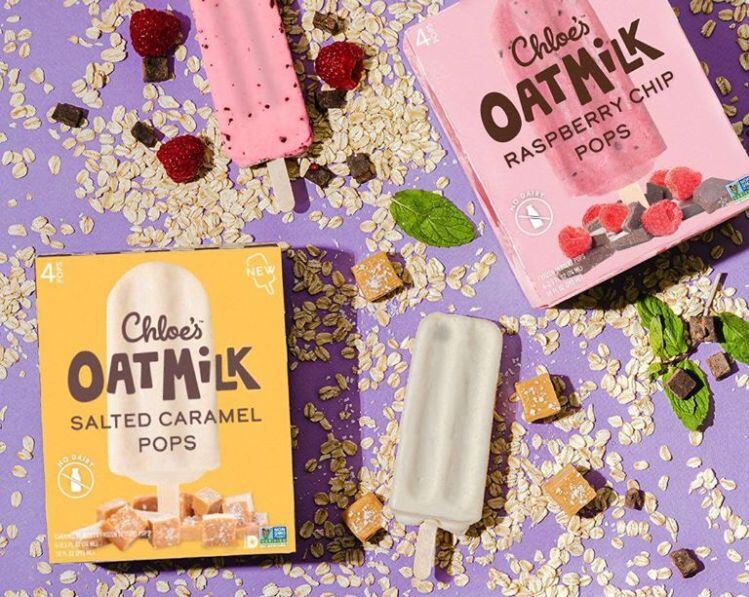
"We have never had a DTC platform but are launching one in the coming weeks to help ensure that our customers have cost effective access to Chloe's without having to leave their homes.
"I do not believe people will begin to trade down on the natural channel. I do think there is a scenario where trial will decline, but I don't think people will abandon the categories, they will just go deeper into the brands they trust and love, and will wait to try new products from unknown brands."
Todd Hoffman, CFO, Chloe's
Nielsen data US retail, week ending March 21, 2020 vs the same week in March 2019
- Total beans: +237.2%
- Rice: +234.1%
- Pasta: +227.8%
- Soup: +237.1%
- Breakfast cereal: +93.7%
- Bread: +69.7%
- Baking yeast: +647.3%
- Canned meat: +282%
- Fresh meat: +100%
- Processed meat: +127.2%
- Fresh meat alternatives: +454.1%
- Fully cooked meat alternatives: +128.6%
- Milk/dairy alternatives: +85.7%
- Yogurt: +33.8%
- Cow’s milk: +52.6%
- Butter: +127.1%
- Oat milk: +513.1%
- Potato chips: +60.7%
- Chocolate: +21.3%
- Ice cream: +50.2%
- Apples: +40.9%
- Bananas: +26.5%
IRI data: Meat sales
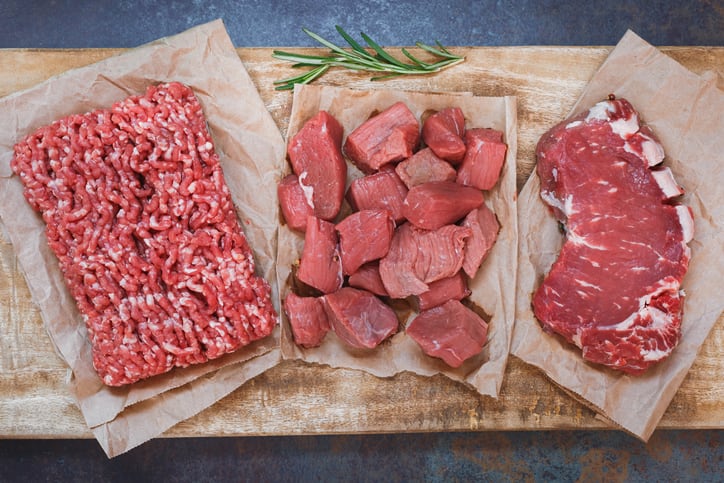
According to IRI, meat has been the leading sales driver for the perimeter, with dollar sales up by 91% year-on-year for the week ending March 22, with volume sales up 78%. "Beef and chicken, the two largest proteins, saw the largest increases in terms of dollars, and turkey was once again the highest in percentage growth.
"In part, these spikes can be attributed to the combination of panic buying and freezer stocking. IRI found that among those stocking up, the top goal is having a two-week supply. However, the sales surges address the increased everyday need as well. The increase in home-cooked meals is a given with mandated restaurant/restaurant seating area closures around the country...
"But also consider the fact that universities and schools are closed, which means many students moved back home... Next, consider the people working from home and all the elementary and high school students being at home... Also consider the fact that all sports and evening activities have been cancelled, so no more 'scramble dinners' to be out the door in 10 minutes, but time to create an actual home-cooked dinner."
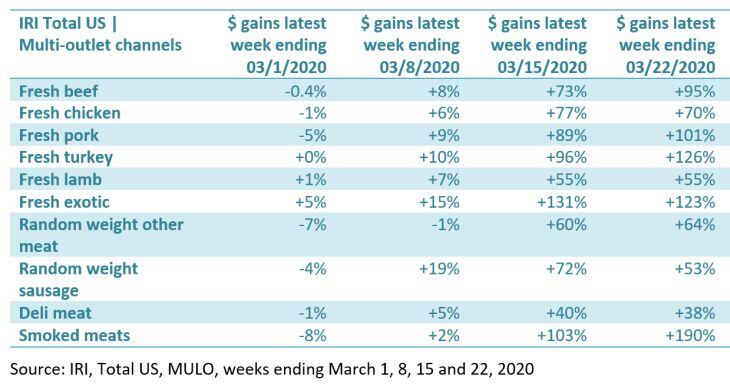
IRI data: Produce sales
According to IRI multi-outlet food retail data (MULO), US dollar sales of fresh produce increased 29.7% year-on-year in the week to March 22, while frozen fruit/veg was up 114.4% and shelf-stable (canned etc) produce was up 158.1%. In the vegetable aisle, shoppers are stocking up on fresh vegetables with longer shelf life, notably potatoes, onions, carrots and squash.
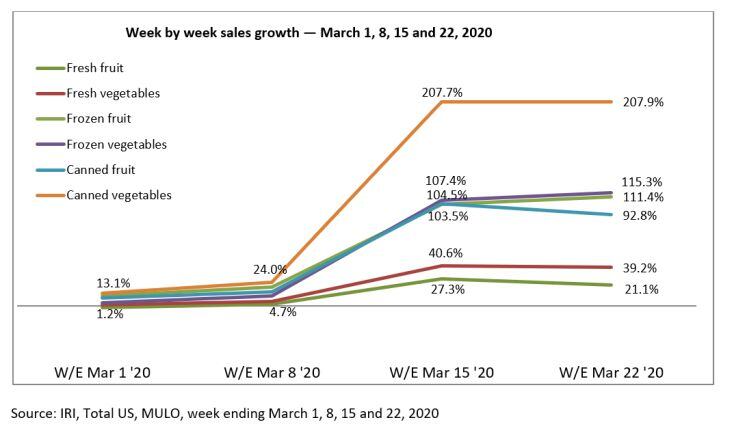
Online grocery shopping: 31% of US households have used an online grocery delivery or pickup service during the past month, according to the Brick Meets Click/ShopperKit Online Grocery Shopping Survey conducted March 23-25, 2020. Monthly users have more than doubled since Brick Meets Click’s August 2019 survey, which found 16.1 million, or 13% of households shopped this way.
26% of online grocery shoppers surveyed said that they’re using a specific online grocery service for the first time.
When asked how likely they were to continue using a specific online grocery service after the COVID-19 crisis subsides or ends, 43% of the survey respondents indicated that they were either extremely or very likely to do so.
“The COVID-19 health crisis has clearly fueled a tremendous surge in demand in the very near term. And, even though some households will not stick with online grocery pickup or delivery services post-crisis, others will shift to this method of shopping going forward for a host of reasons. This is an important shift for the industry, and we will continue to monitor the trends,” said Bill Bishop, chief architect, Brick Meets Click.
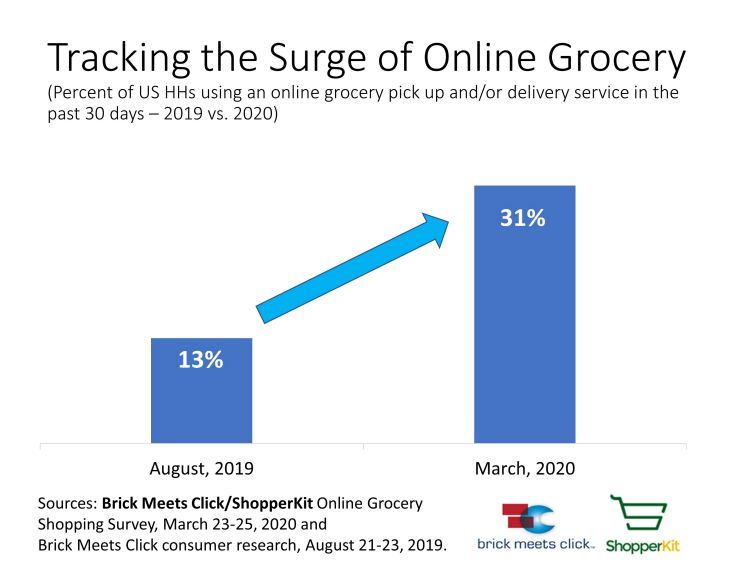
Restaurant traffic update
According to The NPD Group, restaurant customer transactions declined by 36% year-on-year in the week ending March 22 (via data from NPD’s CREST Performance Alerts, which provides a weekly view of transactions and shares trends for 70 quick service, fast casual, midscale, and casual dining chains).
Customer transactions at quick service restaurants, which represent the bulk of restaurant industry transactions and have more off-premise business than full service restaurants, decreased by 34%. At full service restaurants, which are heavily reliant on dine-in sales, customer transactions dropped by 71%.

